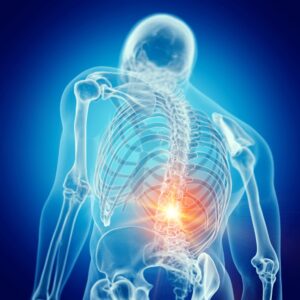Lower back pain affects 60-80% of people throughout their lifetime and is the 5th most common reason for physician visits. There can be many causes of low back pain which can include pain from mechanical, neurogenic, visceral, metabolic, or psychogenic origins.
The clinical course can be described as acute, subacute, recurrent or chronic. There are a number of potential musculoskeletal and neurogenic nociceptive pain generators, some of which include: the facet joint capsule, lumbar disc, spinal nerve root, surrounding myofascial structures, sacroiliac joint capsule, and long dorsal ligament to name a few.
Low back pain can be localized to the low back itself, or also carry radicular/referral features into the hips, legs and feet. If there is secondary neuropathic pain, there could be referred burning, numbness, tingling, crawling or electrical type sensations into the unilateral or bilateral lower extremities.
A referral to an appropriate medical practitioner may be required when:
1) the findings are suggestive of serious medical or psychological pathology
2) the reported activity limitations or impairments of body function and structure are not consistent with the clinical examination and/or
3) when the patient's symptoms are not resolving with interventions aimed at normalizing the patient's impairments and overall body function.
Interventionally, it is important to understand that although a widespread belief and concern are that getting older causes or worsens back pain, research does not support this, and evidence-based treatments can help at any age. For acute and sub-acute back pain, tissue healing usually occurs within 3-months. If pain continues past this time, it is usually because there are other contributing factors needing to be addressed. Many incidences of low back pain happen with no injury at all, or with small microtraumas which make the back sensitive to movement and loading.

Lower Back Pain
It is common for western medicine to work off of a biomedical model where the results of diagnostics including conventional radiographs (x-ray), MRI and CT Scans are the basis for diagnosis. However, these scans have been shown to only be helpful in a minority of people with low back pain. These images often reveal disc bulges, degeneration, protrusions and arthritis. Unfortunately, what these reports do not say is that these findings are very common in people without back pain as well, and they do not predict how much pain you feel or how disabled you are.
The pain that you feel during movement often reflects how sensitive your structures are, not how damaged they are. It’s safe and normal to feel some pain when you start to move and exercise. This usually settles down with time as you get more active. Other treatments include manual therapy and, in some cases, thrust manipulation procedures to reduce pain and disability. Trunk coordination, strengthening and endurance exercises can be employed to reduce low back pain and disability.
Centralization and directional preference exercises and procedures often called “repeated movements” can promote the reduction of symptoms in patients with acute low back pain with referred symptoms. With referred back pain, lower quadrant nerve mobilization procedures can be used to optimize any neuromechanosensitivity. In certain subgroups of patients, mechanical traction may be of benefit. Patient education and counselling can be used to advocate that the client remains active.
It will explain the anatomical and structural inherent strength of the human spine and include neuroscience that explains pain perceptions, and the overall favourable prognosis of low back pain with a multimodal approach. Early resumption of normal or vocational activities should be encouraged, even when still experiencing pain. All of these interventions will have the ultimate goal of improving activity levels, not just pain relief.
References:
1. Casiano VE, De NK. Back Pain. InStatPearls [Internet] 2019 Feb 24. StatPearls Publishing. Available from:https://www.ncbi.nlm.nih.gov/books/NBK538173/ (last accessed 21.1.2020)
2. JOSPT Clinical Practice Guidelines Low Back Pain (2012)
3. O’Sullivan P et. al, Back Facts. BJSM (2019)





